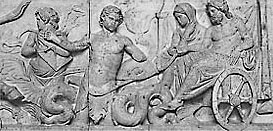
Altar of Domitius Ahenobarbus
"Dulce et decorum est pro patria mori": "it is a lovely and a splendid thing to die for one's country." (1) As Rome began her glorious rise to world dominance, it never forgot Horace's now famous words. Rome's roots were in the fields of Latium and based on the ideology of mos maiorum or respect for the old ways and ancient customs. Even when the Empire was at its height, the ideals of patriotism, hard work, and frugality were still held in high regard, if not practiced. The Roman people had their origins in a philosophy in which the individual was subservient to the state and to the all-important state religion, and when duty called, the peasants and rural aristocracy answered. It has long been suggested that Rome's greatness and strength were based on the fact that the majority of its military men came from the Roman agricultural class - men who were used to long hours and hardships.(2) From the ousting of Tarquinius Superbus, the last Etruscan king of Rome in 509 BC, through the terrible years of war with Hannibal, to the never-ending imperialistic battles on their borders, Roman citizens were called to duty for the sake of their country. Cicero wrote, "the strength of Rome is founded on her ancient customs as much as on the strength of her sons."(3) How did the culture of the Romans and their political and territorial ambitions affect its art? What was Roman about Roman art?
The conventional nature of the Roman people was depicted in their art, and it certainly contributed to its realism. But they also had an agenda, if not a mission, to "write conquerors and conquered in one community"(4) and used their art to help their cause. Many aspects of Roman Art are truly Roman, but the one that stands in the forefront is their use of relief sculpture in an historical and propagandistic manner. The Romans were influenced by their Etruscan neighbors and the Greeks,(5) but there was far more to their art besides a duplication of another culture. Historical reliefs were typically Roman.
Did the Greeks make use of relief sculpture to tell historically-based stories? The closest they came to this art form was the Parthenonic Frieze which portrayed "the use of more generalized mythological symbols - the battle of the Gods and Giants, the Greeks and the Amazons, and so on."(6) Can that be called an historical depiction? The Greeks believed their roots were with the Olympian Gods, especially the Athenians, who saw their city's origin as a contest between Poseidon and Athena. So much of Greek art is tied to myths that were circulated orally and chronicled by Hesiod and Homer. The Greeks may have viewed events, such as the Trojan War as true, but they cannot be substantiated by historical writings. The Romans may have used allegorical representations in some of their reliefs, but they were not the focus.
Emperor Augustus made use of many mythological suggestions in his reliefs to connect himself to Aeneas and Apollo, but he was also making reference to the glorious lineage of the Roman people. It was the destiny of Romans to rule large groups of people because they had the blessings of the gods. As Horace said, "it is by obeying the gods, O Roman, that you will rule the world."(7) The Romans often depicted real events on their sculptured reliefs and erected them on public monuments such as arches and temples. The Romans definitely used historical relief sculpture for propagandistic purposes and to build their empire. The Roman Empire eventually included numerous nationalities and cultures, and their artisans undoubtedly came from everywhere, but the art they produced must still be considered Roman because it was the Romans who commissioned it.
The earliest historical relief that survives is the one dedicated to Aemilius Paullus in 168 B.C.(8) The historical battle between the Romans and Macedonians at Pydna is depicted. Aemilius Paullus was the Roman general and was heralded for the victory. The relief reproduces how the battle began because a stray horse ran towards the enemy. In the Life of Aemilius Paulus, Plutarch gives a description of the triumphal procession after the Battle of Pydna. He wrote that Paullus had brought many riches back to Rome with him. Silver, gold, paintings, jewels, and many statues, including one of Athena by Pheidias were brought back as spoils of the war.(9) Two hundred and fifty wagons were needed to carry all of it, and was said to include "all the gold utensils used at the table of Perseus."(10) In the same work, Plutarch discusses how Paullus had hired Greek teachers for his children and used King Perseus' library to instruct them. The valuable books were part of the riches that came from Macedonia.(11)
The battle was depicted in sculpture because the Greeks were happy to be free from Macedonia's power and wanted to show their gratitude to Rome. The sculpture also symbolized a very important turning point for the Romans, for they were beginning to move east. In 146 BC, Greece would fall to them, as well. An important historical relief from the same period is from the Altar of Domitius Ahenobarbus. A religious practice known as a suovetaurilia, and an historical census taking are depicted. The influence of its "comic-strip"(12) style will be seen later when it is used on large public monuments such as the Column of Trajan.

By 44 BC, Julius Caesar was dead and civil war resumed. Although Augustas had been named his heir, he was challenged. It took the Battle of Actium in 31 BC to secure an opportunity for Augustus to prove himself worthy of the responsibility and a permanent place in Roman history. Augustus was Rome's first emperor, and the Roman empire was born with him. A political phenomenon that would last some five hundred years, it was Augustus who would set the standard for the emperors who followed him. He was a moral, frugal man, and he brought peace to the Roman World. The ancient historian Strabo said:
It is difficult to control and administer an empire as large as Rome's other than by entrusting it to one man, as to a father. And indeed the Romans and their allies have never enjoyed such an abundance of peace and prosperity as that which Augustus Caesar provided from the time when he first assumed absolute power.(13)
Historian Velleuis Paterculus was a contemporary of Augustus' and had the following to say of the emperor:
Trust has returned to the Forum ... justice, equity, and diligence, long buried and forgotten, have been restored to the state ... When was peace more auspicious? The peace of Augustus has spread into the regions of the rising sun and of the setting sun ... the peace of Augustus protects every corner of the world from fear of banditry ... The provinces have been liberated from the outrageous misconduct of magistrates. Honor lies waiting for those who deserve it ... And the best emperor teaches his citizens to do right by himself doing right. Although he is very great in his authority, he is even greater by his example. (14)
Augustan Art reflected all of his qualities and the peace he brought to the empire. Above all, he was a master of propaganda, using art for the good of Rome.
The Ara Pacis Augustae was built between 13-9 BC, and was covered with relief sculpture that portrayed realistic events and divine intervention. The procession scenes of the Senate and the Imperial families may have harkened back to the Parthenon Frieze but processions were an activity which did take place in Roman society. The fact that children were included in the relief displays the more down-to-earth and familial nature of the Romans when compared to the Greeks, who did not show children in their art. Augustus also included his grandsons in the relief, because they were important to him and had hopes that they would play a role in continuing his dynasty. Augustus had passed laws during his reign that were aimed at encouraging Romans to have more offspring.(15) He was particularly concerned that the patrician class would die out. The portrayal of children in art was a symbolization of successive generations.
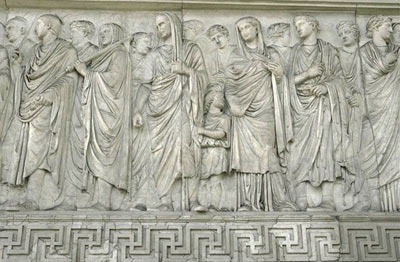
The Battle of Actium is also alluded to with the swan symbols of Apollo.(16) This is another example of the propaganda that Augustus used in his art. He wanted people to connect the gods and his coming to power after the Battle of Actium, a battle in which he had received divine help. The historical event is intermingled with the supernatural. The god-like Aeneas is shown performing a traditional Roman religious practice of sacrificing to the Penates. Aeneas alludes to the founding of Rome, as do the depictions of Romulus and Remus on the monument. The fruit and garland motifs which were carved on the Ara Pacis symbolized the bountiful harvests and peace that were prevalent while Augustus was Emperor.(17) He also erected many buildings and rebuilt eighty-two temples during his reign(18) to ingratiate himself with his subjects, and to present the glory and piety of Rome. Augustan Art was used to commemorate the Emperor and his achievements, but also to celebrate the Roman Empire and its far-reaching power.
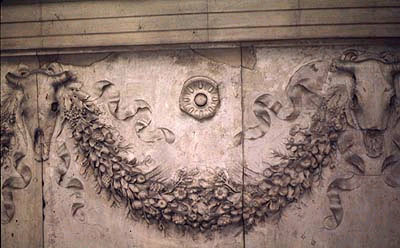
Relief sculpture was not only used in Rome but could be found all through the empire's provinces. Its subjects were never to forget who had won the border skirmishes and territorial battles. Many dialects and languages could be found within the empire, so how could the conquering Romans relay their message of superiority, legitimacy, and victory? They used art. Art is a great communication tool because it doesn't matter if a person can't read or write or even hear. As long as they can see, they can enjoy art and absorb the messages behind the images. The other factor was literacy rates were quite low among the Roman people. If their emperor was going to use propaganda to elevate himself and his exploits in their eyes, posting a written proclamation on the wall of the Forum wasn't good enough. Instead, Roman emperors carved images to represent their feats. All of them seemed to understand the importance of depicting themselves as larger than life, and were shown in similar poses such as the adlocutio position.
Many relief sculptures were erected on buildings, temples, and arches throughout the empire. A very good example is the triumphal arch at Orange in Southern France. Whether it was built in 26 AD or much later is not important for this paper - the point was that when people saw it they understood its meaning. The monument was erected to commemorate a rebellion that had been put down by the Romans; the heaps of captured armor that were represented told the story. These provincial reminders were erected as symbols of Rome's power, as were the defensive walls like Hadrian's Wall in Britain. They were at the same time defensive and symbolic.
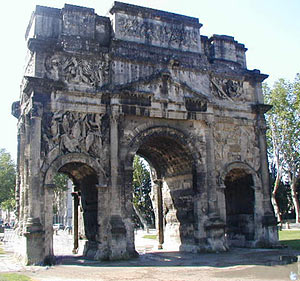
Some of the finest examples of historical reliefs can be found on the Arch of Titus in Rome, which was erected in 81 AD. Titus was a member of the Flavian Dynasty, which ruled the empire from 69-98 AD. He was a military man and had gone to fight in Palestine with his father, the Emperor Vespasian. They had fought the Jewish Wars of 70-71 AD together and had come back victorious. When Vespasian died, Titus succeeded him, but lived only two more years. His brother Domitian erected a triumphal arch to commemorate him and the victory won in the Jewish rebellion.(19) Many riches came to Rome from Palestine, along with religious objects such as the sacred Jewish "Menorah" which is given center stage in one of the reliefs. The relief depicts the triumphal procession with all the prizes of war going through an arch that has been identified as the Porta Triumphal in Rome.
The second relief on the Arch of Titus shows him returning victorious with the goddess Roma, again reinforcing the divine approval that was given to Roman military operations. The Arch of Titus is the earliest sculptured arch in Rome that has survived with the reliefs in place.(20) A clear propagandistic message was conveyed with the art: if the Jewish people wanted to rebel, then the Romans would even strip them of their religious artifacts. A peculiarity of the Arch of Titus is the depiction of a deity taking part in an historical event. This is the first time that this iconography was seen,(21) but it later became a conventional technique. The Cancellarian Reliefs are fine examples of the divine mixing with the human, and included representations of Roma in Vespasian's Adventus in 70 AD, and Minerva with Mars in Domitian's Profecto in 83 AD.
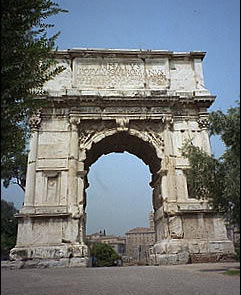 Arch of Titus |
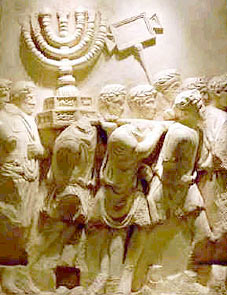 Arch of Titus, detail |
Just as Hellenistic Alexandria in Egypt was a thriving cosmopolitan city, so too was Rome. It was the seat of power in the empire and people of all nationalities went there to work or visit. When they saw the public art, the messages it conveyed must have been quite powerful to some of them. Rome was willing to be fair and would later grant citizenship for everyone living in the empire, but if trouble erupted, it would surely be the victor.
Official monuments like the Arch of Titus were commemorative, used to honor the emperor and his achievements, and to celebrate the glory of the empire and its people. As Otto J. Brendel points out in Prolegomena to the Study of Roman Art, there were two kinds of Roman Art - the private and the public. The populace often favored "landscapes and still lifes, religious ceremonies, mythological or legendary narratives, and family portraits."(22) Of course, the emperors had their own private art collections that existed quite apart from the official art they commissioned. Some, like Hadrian, collected Greek sculpture and paintings. As can be seen with the Gemma Augustae, sometimes the emperor's private art had as many political connotations as it had personal symbolic meanings. Of course, there can be no question that there were divisions within Roman Art. As Brendel discusses:
The point is that in Roman art, as in Roman juridical thought, a fundamental division existed between a "res publica" and a "res privata". As either province of the common social order possessed its own store of themes, mythologies and ideologies, ... the arts provided different traditions, iconographies, and styles for either area ... One serving the needs of the state and the other the spheres of private concern.(23)
The common people had their own interests in art and enjoyed it in their homes. The nouveau-riche like Trimalchio used it as much for enjoyment as they did for prestige. But public art was commemorative and carried a message, and the most august illustration is the Column of Trajan.
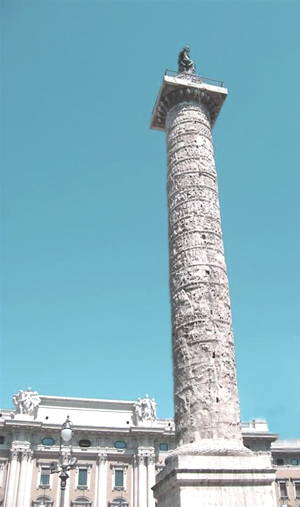
Towering into the sky like a beacon stands the Column of Trajan in honor of a man who was loved and respected by his people. He was known to be a great general, who was also intelligent and wise, and his reign harkened back to the time of Augustus and brought "confidence in the greatness of the empire."(24) Trajan became emperor in 98 AD and ruled for almost twenty years. During his reign, he commissioned the grandiose Forum and Markets of Trajan, and the Aula, which formed part of the complex containing some of the most unusual vaulting techniques known to the Roman World. For his people, he built a huge bath complex. Baths were as typically Roman as historical reliefs were and formed an integral part of their lives. The propaganda message to the Romans was clear: their beloved emperor cared about them and wanted them to have the best. He did not mind spending large amounts of money to provide them with it. Dio Cassius wrote that:
Trajan spent great sums on wars and equally great amounts on the works of peace, and although he carried out a great many very necessary repairs on the roads and harbors and public buildings, he did not bleed anyone dry for any of these. He was so generous and magnanimous that, when the Circus had fallen into decay, he restored it on a greater scale and in a much more beautiful fashion and then added an inscription saying only that he had made it adequate for the Roman people.(25)
But first and foremost, Trajan was a military man, and during his reign the empire grew dramatically. He saw the Dacian people as a threat to the peace that was settling over Europe and wanted Dacia to become a province of Rome. They resisted, and it took two separate wars to bring the Dacians under his power. The Dacian campaigns were commemorated on the one hundred foot high Column of Trajan, and dedicated to the emperor in 113 AD. The tale begins above the base in the countryside of a place called Dacia and on the banks of the mighty Danube River. The Dacians wanted to be free and independent, but the Romans insisted they become another piece in their huge jigsaw puzzle of an empire. Trajan fought them from 101-102 AD until a treaty was agreed upon, but trouble broke out again in 105 AD. Trajan and his troops fought in Dacia again until 106 AD,(26) this time unwilling to leave without total submission and the annexation of the province.
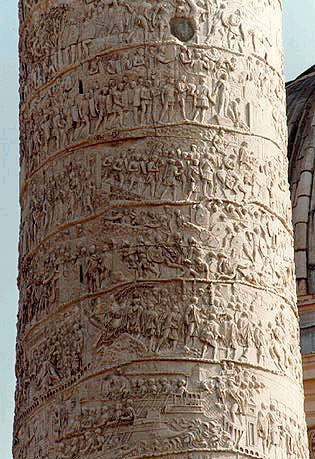
The historical episodes take the form of 155 vignettes, which run together and sweep up and around the huge column. The same "comic-strip" premise that was found on the Altar of Domitius Ahenobarbus is seen again on the Column of Trajan, giving it the feel of a sweeping and continuous narrative. Trajan is shown over and over again in many different contexts, but always majestic and larger-than-life. It was a story about him, his power, courage, and accomplishments, and the artists carved his image with this in mind. The detail given to the clothes, armor, and shields of both armies allows the viewer to easily differentiate between the Romans and the Dacians, and the enemy and their leader Decebalus are given a measure of dignity on the column. Although no mistake can be made about who the victors were in the Dacian campaigns, the cruelty that was later seen on the Column of Marcus Aurelius had no part to play on this monumental piece of art. Cruelty had no place in Trajan's portrayal because he did not wish to be seen in this way. His Column told the details of an historical event and was used to promote his position within a great empire. As Ramage and Ramage have observed:
But even more important than historical accuracy was their aim of extolling the virtues of the army and the emperor. In fact, details of the events were often reduced to stock scenes that could be repeated, without historical basis, as long as the viewer was kept constantly aware of the greatness of the Roman state through its chief citizen and leader. Thus, the propaganda message took precedence over accurate details, and the Column of Trajan exemplifies in its greatest form what the Roman historical relief is all about.(27)
How the Column was viewed and read has been the subject of many articles. It is unlikely that it was carved and erected in a manner so that everyone could understand it from beginning to end. Trajan wanted the events of the campaigns to be depicted as closely as they could to convey reality, but it is very doubtful that he expected people to analyze every section of it. The same is true of newspaper publishers today. They don't expect many people to read long columns on even the most important issues. That is why headlines are so significant and short condensed texts are written and printed on the major events. People would surely visit his Forum and look in awe at the spectacular column that was positioned between the libraries, but most ordinary Romans were not art critics. They would only be expected to understand that it told a story about the power of the Roman Empire and that their emperor was very brave.
Art played a significant role in the politics of Rome and in the expansion of the Empire. Historical reliefs in particular played an integral role in the ambitions of the Romans and in conveying messages of propaganda. Art reflected their culture and commemorated their emperors. The story of the Romans is quite a remarkable one and their legacy to us has been very profound. T.S. Eliot wrote:
We are all, so far as we inherit the civilizations of Europe, still citizens of the Roman Empire, and time has not yet proved Virgil wrong when he wrote, "for the achievements of the people I fix neither spatial boundaries nor temporal limits: I have given them empire without end."(28)
They began their civilization in little huts, but they had big dreams and great perseverance. The Romans ended up accomplishing many remarkable things.
Related Papers
Ancient Athenian Women: A Look at Their Lives